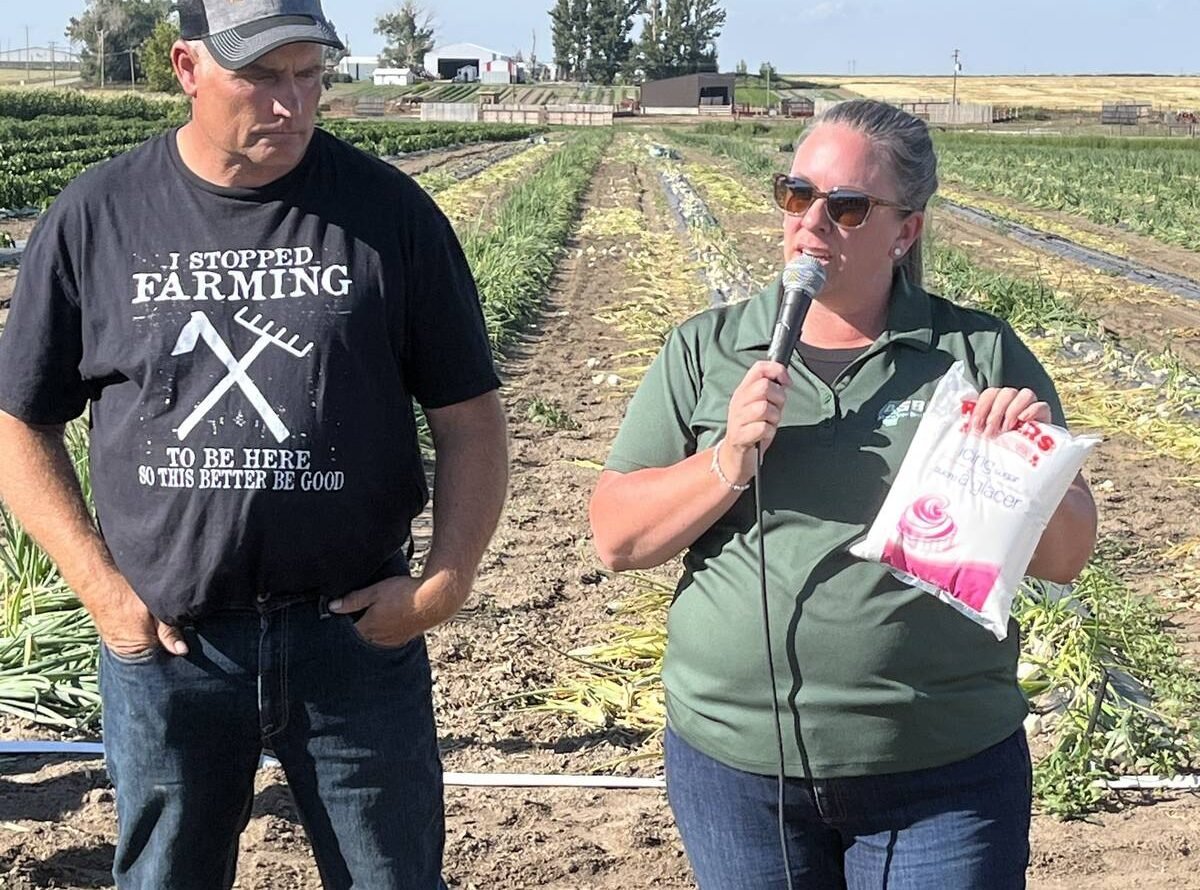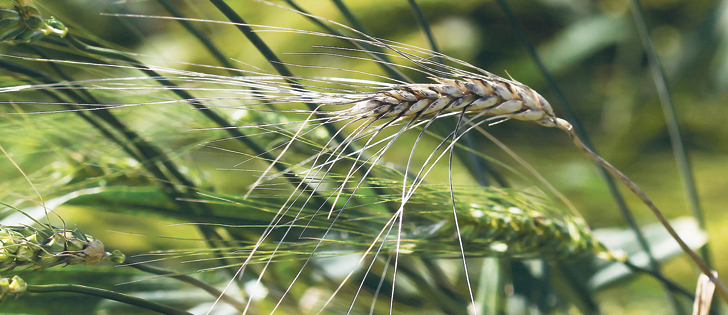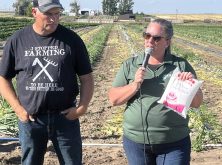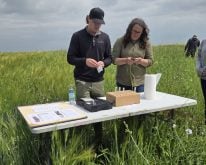Fungicide application has become routine. It’s every crop, every year in order to extract every last bushel. But with only three main modes of action, responsible rotations are somewhat limited.
On paper at least, routine fungicide spray pencils out pretty well in all the main crops. The expected yield bump and quality benefit outweigh the cost. But are we painting ourselves into a corner by pursuing those last few bushels?
The agriculture industry as a whole concedes that our current problem with herbicide resistance is a result of mismanaging weed control programs decades ago.
Read Also

Alberta’s beets a sweet domestic segment in Canada’s sugar supply
The sugar beet industry is showcased during a Farm to Table tour, as Taber features the last remaining sugar beet processing plant in all of Canada.
Glyphosate is an example of how over-dependence got the industry into trouble in some cases. It was too easy to do a burn-down that killed all weeds and most volunteer crops. But when the “do-all” weed killer doesn’t “do it all” anymore, where do farmers turn?
Until ascochyta in peas came along, most people didn’t think fungicide immunity was in the cards. However, producers are now asking if they’re risking the same kind of immunity in all crops by over-dependence on fungicides?
When there is herbicide immunity in a field, producers can see the resistant weeds that herbicides can’t kill. That’s easy. But farmers cannot visually identify fungicide resistance. To compound the situation, nobody tests for fungicide resistance.
“There isn’t anyone actively testing for fungicide resistance in most pathogens,” said Manitoba Agriculture plant pathologist Holly Derksen.
“Fungicide insensitivity could be building up slowly over time, but since we aren’t looking for it, there’s potential for it to catch us by surprise. Granted, it might be a long time from now.”
Western Canada is still relatively safe, but it could be throwing away its enviable position if the industry doesn’t grasp the hard take-home message learned from our herbicide experience, said Bayer’s Jared Venes.
“We’re getting more and more questions about fungicide resistance,” he said. “Nobody wants to be in the situation in the future with fungicides that we’re in right now with herbicides.”
Venes said wet weather in recent years has been more conducive to fungal outbreaks and thus promotes fungicide use.
“But also, there’s been a shift in thinking. When the new active ingredients came on board, guys realized they were leaving bushels on the table by not using fungicides. The math justifies the added expense of routine fungicide.”
Venes said there’s one big difference between fungicide resistance and herbicide resistance: disease needs a host.
Weeds don’t need a host, just soil. The progeny of a resistant weed will be in the same field in the same spot the following year. If left unchecked, it will continue to drop seed, and the population of resistant weeds will grow.
He points out that producers are in a different situation with disease. Depending on the disease, eliminating the host plant for a year or two can eliminate the disease temporarily.
“If you had fusarium head blight in your wheat, you can put canola on that field the next year and eliminate the fusarium host. Fusarium won’t affect your canola. Or if you had sclerotinia in your canola, you can put wheat on that field the next year and eliminate the sclerotinia host. Sclerotinia won’t affect your wheat.”
He said the factor working against farmers is that there’s essentially only three modes of action in foliar fungicides:
- Group 3 triazoles are demethylation inhibitors, also called sterol biosynthesis inhibitors.
- Group 7 is succinate dehydro-genase inhibitors (SDHI).
- Group 11 is strobilurin.
“Our options are more limited in fungicides compared to herbicides, so fighting disease requires a higher level of management. All the different fungicides have a different propensity to develop resistance,” Venes said.
“The riskiest mode of action fungicides are the Group 11 strobilurins. Somewhat less risky are the Group 7 SDHI fungicides. The least risky are the Group 3 triazoles. This is what we have to work with right now because it’s becoming more and more difficult to get a new mode of action registered.
“The first mode of action to break down are strobilurins, so they’re risky right from the start. That’s why they’re supposed to be used in mixtures with other modes of action.”
He said fusarium, sclerotinia and rust are the pathogens of most concern to western Canadian farmers. However, these are considered to be low risk pathogens, he added, based on the number of life cycles per growing season and experience from around the globe.
“Zero till has provided a nice winter environment for pathogens,” he said. “Fusarium head blight in wheat, for example. If you could burn that innoculum every year, you’d reduce your disease problem for the following year. But something like rust, there’s no risk mitigation strategy to fight rust because about 99 percent of the innoculum is blown up here from the U.S.
“However, there are a number of things you can do agronomically to reduce your risk by half. Use disease resistant cultivars. Use the registered rates instead of cutting your rates. Herbicide resistance is a result of guys cutting their herbicide rates to save money.”
He said farmers didn’t kill all the weeds when they cut herbicide rates. The weeds that survived were the ones that tolerated the herbicide, so growers inadvertently selected the resistant weeds, and those were the weeds that grew the next year.
In effect, it was a plant-breeding program that produced disastrous results. Venes emphasized that reducing fungicide rates will also allow some pathogens to escape.
“The three high-risk pathogens prominent in western Canada are alternaria, grey mould and powdery mildew. For those, you would avoid a straight high- risk fungicide like strobilurin multiple times in the same year.
“We’ve already experienced fungicide resistance in Western Canada. That was ascochyta in chickpeas.”
He said in early 2000, when strobilurin chemistry came on board, it was exactly what chickpea growers needed because there were very few varieties with disease resistance.
“The growers started spraying their chickpeas three, four, even five times a year with straight strobilurin. Most of the chickpea growers were in the same geographic areas. Ascochyta is a medium to high risk pathogen and the spores are wind borne. It was a worst case scenario.”
On the bright side, Venes said cereal crops generally get just one application, canola averages less than one application and pulses get one or maybe two applications targeting different pathogens in the same year.
“Comparing Western Canada to the rest of the world, we’re in a pretty good situation in terms of fungicide use, resistant cultivars and a small number of high risk pathogens,” he said.
“One thing we can do is to spray preventatively. Try to eliminate the pathogen before it gets a stronghold in your crop. That’s better than going into a disaster and trying to fix it.
“Always keep disease in mind when designing your rotation. When you rotate from one type of crop to another, you’re eliminating the host. Crop rotation is every bit as important as rotating your mode of action.”
















